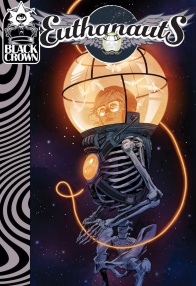What is life if not a book and death the closing of it? There is always the possibility of a sequel, of a continuation. Maybe even a series. Maybe they’re all unconnected, save for a few details, or maybe they’re one long narrative, spanning eons and eons. What if you could go be conscious during the transition from book to book? What if you could be a Euthanaut? What if you were forced to be one? Minor spoilers ahead.
Written by Tini Howard
Illustrated and Colored by Nick Robles
Lettered by Aditya BidikarDeath is like outer space—a seemingly unknowable, terrifying blackness that yields beautiful discoveries and truths—if only you’ve got the right kind of rocketship. Thalia Rosewood has had a lifelong obsession with death, keeping her from living her life to the fullest. Mercy Wolfe has a brain tumor the size of a billiard ball, and a need for a new recruit before her next journey begins. Inigo Hanover is a reluctant tether to the world beyond, seeking to continue a cycle that exploration would halt. Go toward the light. Then go beyond. EUTHANAUTS.
My book metaphor may have gotten away from me but it’s because “Euthanauts” is a tough nut to crack. Intriguing in premise, promising in concept, baffling in execution and ethereal in presentation, it’s hard to find the right place to start talking about it. I’ll try anyway. The concept of there being something after death is an idea that is the old hattiest of old hats yet we return to it, time and time again, with new takes, new ideas, and new adventures. There is something alluring about the prospect of knowing what lies in the unknown. It’s why we write fiction about space, about our oceans, our minds…about other people.
As such, it’s no surprise that Howard, Robles, and Bidikar invite us to enter the mind of Thalia, a person whose thoughts are preoccupied with death, with the concept and state of death. She is a Euthanaut, a traveler of good deaths, although at the start it is only her thoughts that are acting in this way. As the issue progresses, the term Euthanaut, takes on a literal meaning and, as the cover shows, a physical form. It is not just the intellectual activity of exploring good deaths that Thalia partakes in, it is also the real, physical act of exploring the state of death.
Robles was the perfect artist to bring this story to life. Every page is composed with an eye for detail, turning up the dial on reality so when the fantastic settles in, it flows perfectly. Take the bottom left panel on page 5. Thalia is sitting with her friends, the ones she’s admitted she doesn’t like very much, staring at the dying woman with the orange balloon. Robles lights and frames this panel so that Thalia and the Balloon pop, drawing the eyes to them.
Her “friends” are silhouettes, despite the overhead light illuminating their faces in other shots. We are in Thalia’s head, seeing what she sees. A dying woman but with a bright, orange balloon, and herself, staring, being called out by this random woman, whose only presence in that panel is an arm and an IV bag, draped in the cool darkness.
There are other panels, other pages that are just as well composed as this one. Despite this, there was one two-page spread whose layout confused me. It is the first appearance of the helm-suit from the cover and while the page itself has a flow of information that should have had me follow the captions and float with the characters, I found my eyes skipping towards the larger, brighter images instead. A small gripe but one which could be the final straw for some readers.
Yes, despite the praise I’ve heaped onto the art and onto the concepts at play here, the actual story being told is obtuse and hard to follow. Thalia’s story is fairly straightforward, up until the part that she’s bonked on the head by an oxygen tank, an image in and of itself, and her character is well defined in the few pages we’ve known her. Yet the larger narrative includes this strange woman who is a self-proclaimed Euthanaut, the dancing mourner from the opening few pages who seem to exist elsewhere, the comedy stylings of the hospital scrubs who seem to know a lot about the Euthanauts, and the vagaries surrounding Thalia’s current dead yet not situation.
Continued below“Euthanauts” #1 is light on answers, more concerned with placing us within Thalia’s narrative position and with setting up the next issue. We’re supposed to be lost, as we’re with Thalia who is just as confused. There is enough grounding to get the basic gist of what’s going on and to begin to piece the narrative together but not enough to have a clear picture of what’s going on. It’s a mystery that not everyone will be on board with, some leaving because they are too confused, others because the concept isn’t to their liking.
I, for one, am excited to see where this goes. Each of the side-characters, despite being in the issue for a brief amount of time, have gotten me engaged in wanting to know more about them and seeing more of their antics on the page. The story seems to know what it is doing, allowing us to stew in the confusion before clearing things up as it goes along. At least, that’s the hope.
Final Verdict: 7.0. A gorgeous comic that has the potential to be great but will lose readers due to an overwhelming amount of information that doesn’t fit together as of yet.




